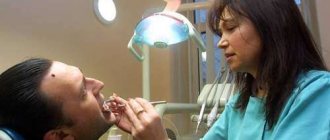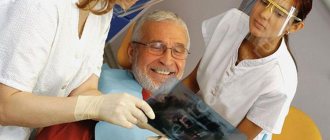Preparing teeth for prosthetics begins with an examination by an orthopedic dentist. It determines the scope and list of measures that will be required to effectively restore the integrity of the dentition.
The basis of preparation is accurate diagnosis. The condition of both jaws can be assessed using a panoramic X-ray - orthopantomogram. It allows:
- see the condition of all teeth;
- assess the condition, volume, structure of the bone tissue of the jaws;
- identify diseases that may interfere with prosthetics (periodontitis, root cysts, etc.);
- determine the condition of soft tissues, the depth of periodontal pockets with periodontal disease, etc.
Based on the diagnostic results, the doctor determines what preparation measures will be required.
Therapeutic preparation
Therapeutic preparation is necessary for the purpose of sanitation of the oral cavity. First of all, professional teeth cleaning is carried out:
- removal of hard dental deposits using ultrasound, less often - mechanical cleaning;
- removing soft plaque using the Air Flow method;
- polishing, fluoridation (remineralizing therapy).
Preparing teeth for prosthetics includes mandatory removal of foci of infection and inflammation. Treatment of caries and complications in the form of pulpitis, periodontitis is carried out, and therapy for inflammatory diseases of the gums and soft tissues of the oral cavity (periodontitis, gingivitis, glossitis, etc.) is prescribed.
Therapeutic preparation also includes removal of the pulp of teeth to be replaced. Afterwards, endodontic treatment is carried out - treatment and filling of the root canals.
Restoring the aesthetics of the dentition
In our clinic, special attention is paid to measures aimed exclusively at restoring a beautiful smile, when a person stops stressing because of his dental problems, he becomes more confident, his life often changes for the better - unnecessary complexes disappear due to bad teeth and stale breathing, obstacles that previously caused serious problems with communication are eliminated, the patient is fully socialized, and his quality of life noticeably improves.
Qualified restoration of the dentition not only returns lost opportunities to the patient, but also prevents further disruption of the chewing system, the condition of the oral cavity, stops and reverses the deterioration of the appearance of the face, which is especially important for women of any age.
Surgical preparation
Surgical preparation involves the removal of teeth that cannot be treated. For example, highly mobile ones, having a large root cyst, granulating periodontitis, etc.
Osteophytes and exostoses, if present, are also removed. They are outgrowths of bone tissue and can interfere with the installation of a denture.
Surgical preparation of teeth for prosthetics may also include removal of excess soft tissue due to hypertrophy of the mucous membranes and gums.
Implant placement also refers to surgical preparation. Osteoplastic surgery, the implantation of artificial or natural bone tissue to achieve the required volume of bone in the jaw, can also be used as a preliminary stage. One of the types of such an operation is a sinus lift, raising the bottom of the maxillary sinus.
Depulping teeth for crowns
The installation of crowns and bridges involves depulpation - removal of the nerve of the tooth. This procedure deprives the tooth of nutrition, it becomes more fragile. However, this cannot be avoided - removal of the pulp during prosthetics in most cases is mandatory. This allows you to avoid a number of problems in the future during the operation of the crown.
As a rule, a crown is installed on a tooth with a damaged coronal part. That is, it is impossible to do without removing the nerve. If we are talking about installing a bridge, the supporting teeth are also processed for the subsequent installation of the structure. It is believed that to install a zirconium dioxide prosthesis, it is not necessary to depulpate the tooth, due to the fact that its thickness is minimal compared to prostheses made from other materials.
Orthopedic training
Orthopedic preparation involves attention to secondary tooth deformations after removal of those located nearby or “antagonist” (located on the opposite jaw) teeth. It involves creating special plates and trays to move protruding teeth to create space for dentures on the opposite jaw. It may also be necessary to make special trays to relieve the masticatory muscles. This is necessary for bruxism and increased muscle tone to prevent damage to structures.
Preparing teeth for prosthetics is a whole range of measures that are designed to prevent the difficulties of wearing artificial structures and are necessary to ensure oral health.
ORTHODONTIC STAGE
At this stage, if necessary, the following problems can be corrected:
- Forms of dentition;
- Positions of abutment teeth;
- Inclination of teeth in relation to missing teeth;
- Fan-shaped position of teeth;
- Pulling out impacted teeth that can become a support for a denture.
During the orthodontic stage, the specialist focuses on secondary deformations of the remaining teeth, if the patient’s neighboring teeth or antagonist teeth were previously removed. Preparation for prosthetics at this stage takes from 2-3 months to 2-3 years.
Features of quota provision
If social security confirms the basis for dental prosthetics on preferential terms, you will be given a coupon for applying to a state or municipal medical institution. The coupon is valid from 2 weeks to six months
. If you do not use the ticket at the appointed time, the queue disappears. The beneficiary is not allowed to choose a clinic. The medical institution is designated according to the place of registration, the name of the clinic and address are noted on the coupon.
Free prosthetics for pensioners are provided in state and municipal dental clinics. According to the quota, they will only make and install dentures for you. Treatment is paid separately. Expensive materials are not used for prosthetics. Such as ceramics, metal ceramics and implant prosthetics. In some cases, for example, with allergies, the doctor may recommend more modern and expensive materials. When making such a decision, the patient will have to pay extra for consumables. Free prosthetics are done only once every 5 years
.
Bridge
The main preparation for bridge prosthetics consists of preparing the supporting teeth. When using metal-ceramic dental prosthetics, the teeth are subjected to significant grinding. Zirconium crowns are much thinner, so not as much hard tissue is ground down.
After this, impressions are made and the frame is modeled based on them. Then the crowns are cast and fired in a kiln. The bridge is tried on, adjusted and placed on temporary cement, giving the patient time to get used to it. After this, the structure is secured with permanent cement.
Required documents
To get in line, you need to contact the social protection department at your place of residence or the local administration with the results of the survey. There you will be given an application form to fill out. Copies of the following documents are attached to the application
:
- medical opinion on the need to install dental prostheses;
- copy of passport;
- pension or other certificate;
- medical insurance (CHI);
- SNILS.
The list may be expanded depending on the preferential category.
If a pensioner cannot come himself for health reasons, a guardian or a social worker will do this for him if there is a guardianship agreement. The entire list of documents will be provided by the social security authorities in your area.
Where to start treatment
Dental prosthetics for pensioners has a number of features. In old age, this is a complex and delicate procedure. A careful and careful approach to treatment is required.
Start by visiting a dental clinic and get a consultation with a dentist. After the examination, the doctor will tell you whether prosthetics can be done and what preliminary treatment is necessary. Before installing dentures, undergo a medical examination. Older patients, as a rule, have a number of chronic diseases and weak immunity.
Please note the contraindications: allergic reactions to anesthesia and substances used in dental prosthetics. It is not recommended to carry out treatment during an exacerbation of diseases of the cardiovascular system and respiratory organs. It is necessary to eliminate inflammatory processes in the oral cavity (stomatitis, bleeding gums). In state or municipal dentistry you can receive treatment under the compulsory medical insurance policy. After treatment, contact your orthopedic dentist and discuss what type of prosthesis and what material will be suitable for your case.
Dental prosthetics cannot be done under the compulsory medical insurance policy.
.
But for pensioners, Russian citizens, social programs
under which prosthetics can be installed for free.
Crowns
Crowns are placed:
- on pulpless teeth to protect them from destruction;
- to units destroyed by more than 50%
; - on teeth in which only the root is preserved;
- with abnormal abrasion of enamel;
- for aesthetic defects, the correction of which is impossible by other means;
- for implants.
After all the preparatory manipulations, the doctor grinds the tooth down to the thickness of the future crown. If the tooth is completely destroyed, a pin is inserted into the root. Then the tooth stump is prepared. It is given a shape that will allow you to put the crown on top and ensure its stability.
After this, impressions of the teeth are taken, always of both jaws, to ensure good occlusion (touch) of the teeth. Based on the impressions, crowns will be made in the laboratory, which the doctor will adjust so that they fit tightly on the supporting tooth.
During the fitting, the orthopedist checks the correctness of the bite, contact with adjacent teeth, and how comfortable the patient is with the crown. For the first few days, it is recommended to wear the crown with temporary cement to get used to it. Then, if necessary, another adjustment is made and the crown is secured with permanent cement.
When installing a crown on an implant, both cement and screw fixation are used.
Basic issues of dental prosthetics
Dear friends, in this article we will try to answer the most asked questions by our patients about prosthetics and preparation for it, about the main stages of dental prosthetics, their order and important key points related to dental prosthetics.
Dental prosthetics is a multi-stage process of replacing lost teeth or damaged tooth tissue with the help of dentures. So, after you have been consulted by a specialist, a diagnosis has been made, a treatment plan has been selected, a treatment agreement has been drawn up, and the treatment stages begin. Any dental prosthetics includes: 1. Preparation for prosthetics, if necessary.
2. Dental prosthetics itself, which includes clinical and laboratory stages.
Preparation for removable prosthetics
After the preparatory work, the orthopedic surgeon determines the type of product, method of fixation, and supporting teeth.
It can be:
- Complete removable dentures. Plate products are made from acrylic, nylon or new polymers such as AcryFree
- Partially removable dentures. There are lamellar, clasp, adhesive, immediate (temporary)
The doctor makes impressions of the teeth, from which plaster or wax models are made in the laboratory, on the basis of which a prosthesis is made. When using clasp prosthetics, a metal arch is cast from selected materials - a clasp, and a base and crowns are placed on it. The orthopedist performs fitting and correction, after which the patient is given time to get used to it. After that, another correction is possible and a rehabilitation period begins. Its duration is different for each patient.
Who's on the benefits list?
The social security department at your place of residence will tell you which prosthetics are free for pensioners. The procedure for providing free services is regulated by federal law, regardless of place of residence. The Federal Law “On State Social Assistance” contains a main list of those who have grounds for receiving free services at the expense of the state budget. Help is provided free of charge
:
- war participants;
- heroes of the Soviet Union;
- victims of Stalinist repressions;
- labor veterans.
Free prosthetics for pensioners in certain regions of the Russian Federation has its own characteristics and is regulated by regional laws.
Next for free services
in prosthetics can apply for:
- disabled people of groups 1 and 2;
- beneficiaries who were in line for preferential prosthetics up to January 1, 2005 inclusive;
- disabled people of the accident at the Chernobyl nuclear power plant;
- pensioners after working in government agencies and law enforcement agencies;
- old age pensioners with a certificate of no additional income.
Taking into account the number of quotas, citizens from the first federal list always have advantages.
Additional benefits may be approved in each individual region. For example, dental prosthetics for pensioners in Moscow with benefits
and
a reduced price
is possible for the following citizens:
- home front workers;
- honorary donors;
- mothers of many children who gave birth and raised 5 or more children;
- non-working pensioners.
The quota distribution is given according to the waiting list. The right of first priority is given to those who are included in the general federal list, regardless of the region. Depending on the membership of one or another category of beneficiaries, the package of documents may change. The complete list must be verified at your place of residence.
Warranty
The service for preferential dental prosthetics for pensioners provides for the conclusion of an agreement between social security authorities and a medical institution for warranty service. Contract duration – 6-12 months
. If the work done by the doctor fails due to a medical error, the clinic is obliged to replace or repair it at its own expense. The cause of the damage is determined by a special commission.
If you follow your dentist’s recommendations correctly, undergo regular preventive examinations, and carefully care for your dentures, your dentures will last from 3 to 10 years.
depending on the type.
Psychological preparation
Most people are afraid of going to the dentist. A tense patient, shaking with fear, does not speak well and is difficult to interact with. The work of an orthopedist begins long before trying on a prosthesis. The first step is to establish emotional contact. If a doctor is friendly and shows attention, he inspires trust. The patient will be more open to discussing treatment methods, and nervousness will decrease. During the conversation, the dentist collects information about:
- patient complaints;
- past treatment experience and its results;
- the presence of common diseases and allergic reactions.
During the examination, the orthopedist pays attention not only to the condition of the oral cavity, but to the asymmetry of the face, recession of the cheeks and lips.
To assess the condition of the teeth and see hidden defects, an orthopantomogram (panoramic image) or CT scan is usually prescribed. This is not a whim of the doctor, but a desire to create a complete picture, taking into account all the details. In addition, the image can reveal inflammatory processes that are invisible during examination.
Based on the results obtained, different types of preliminary treatment are prescribed.
- Alekperov R.B. Orthopedic dentist
Question:
I don’t want to remove the nerves in the supporting teeth for the bridge. What are the options?
Answer:
A bridge prosthesis based on zirconium dioxide involves the production of thin crowns for supporting teeth, so in some cases it is possible to do without their heavy grinding and depulpation.
- Pak R.V. orthopedic dentist
Question:
When the teeth are ground, will they put something on the stump? Or just walk around with sharp fangs
Answer:
After the teeth have been prepared, protective temporary crowns are placed on them until the permanent prosthesis is installed.
< Previous Next >











